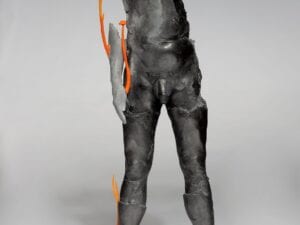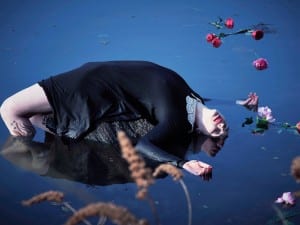Hand-cut line by line, Jukhee Kwon’s Babel Library is created from disposed editions of Encyclopedia Britannica. Transforming whole objects into another through deconstruction, brings them back to life, allowing the viewer to emotionally connect with the history of the book, as the pages drop to the ground. As part of the Aesthetica Art Prize Shortlist 2018, Kwon discusses the nature of the texts and his material inspiration.
A: Your work focuses on communication in analogue forms. What first drew you to adopt books as an artistic medium?
JK: When I was working as an illustrator, I had a deeper longing to create something three dimensional with books. What triggered me to start working with books was my education and living in London since 2012. I was in a course which covered Art Books at Camberwell College of Art for my MA. Through that course I started to understand books in many other ways and different formats. That helped me open up my mind and the range of my imagination.
Books are a lot like the phenomena that you find in the natural world, for example, an animal, a tree or even a human being. It is born and lives and dies … Books also communicate something through material senses. We see it, touch it and smell it as well as we read. Old texts communicate their history—how old they are, by who it was owned, how it was treated before and how it finished. At every level, the objects speak not just on the level of the words, but have a mysterious ability to communicate thoughts and feelings to those who interact with them; as such, they are a perfect artistic medium.
A: Do you prefer working with reused materials rather than raw resources and plain backgrounds and why?
JK: Used material has passed its own time and has a history that makes me more interested in working with it. It contains some notes and fingerprints of people who used to own or simply who touch the book; it stores its own particular smell and colour that evoke an artist’s inspiration.
A: What challenges does the use of books present in comparison to other media?
JK: The biggest challenge that I have from using books is how to keep the peculiarity of the paper (soft and natural) and still control it to create sculptures and installation work. What I have learned since using paper is that I can’t control it all of the time; I have to let it have its own quality. I start each piece with respect rather than a spirit of domination.
A: Babel Library is shortlisted in this year’s Aesthetica Art Prize. How do competitions such as this affect the development of your work?
JK: Not only was it about the competition, but the prize also presents a chance to expose my work to new audiences. All art starts as an idea, and I’m looking to communicate the quality of these material objects and express my fascination with others.
A: The work transforms a collection of static Encyclopaedias into a singular cascading sculpture. How does the work illuminate the ways that digital culture has impeded on everyday life?
JK: It is true that we live in digital world nowadays. Rather than going to the library, it is enough to switch on the computer, connect to the internet, and type in the information you are searching for. But sometimes we get lost in the information appearing on the screen. The digital world is invisible with no physical body that you can physically feel and touch. It is rather like an illusion or a dream. Babel Library is in front of you, claiming its existence. You can touch, you can smell and you can feel it directly! It contains all the information in itself. It is an natural process to turn it from static form to cascading form whereas the internet is artificial rather than natural.
A: The sculpture also uses printed language in order to create a flowing form. How does this mimic the way language facilitates daily life?
JK: An encyclopaedia contains a lot of information ordered in alphabet order. After it is shredded, it is all mixed, but it is a new babel with a new form. The new form has meaning that communicates something—in the case of my art, not linear or straightforward. Without delving into “philosophy of language” or “analytic philosophy,” the higher uses of language, such as poetry, begin to break the linear structure and meanings that we impose upon words. Words have a mysterious quality to express and when you transcend the linearity, you can communicate mysterious things.
The Aesthetica Art Prize Exhibition runs at York Art Gallery from 18 May. Find out more here.
The Aesthetica Art Prize is open for entries until 31 August. To enter your work in Photography & Digital Art; Video Installation & Performance; Three Dimensional Design and Sculpture or Painting and Drawing, click here. Prizes include £5000, publication and a group exhibition at York Art Gallery in 2018.
Credits:
1. Jukhee Kwon, Babel Library.
Join the Conversation. Follow us on Instagram, Twitter, Facebook and Pinterest.





